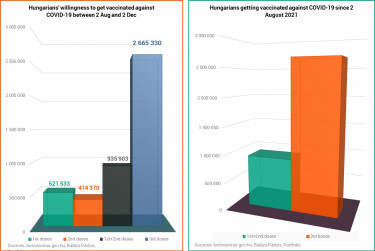COVID-19: More than 10,000 new cases, 191 deaths in Hungary

As of Monday, without any warning, remark or explanation, the Coronavirus Task Force started to publish only the number of Covid patients in invasive ventilation. The number of patients supported by noninvasive ventilation (NIV) is not published.
In effect, the Coronavirus Task Force has rendered a key metric of the pandemic quasi useless.
Since we would like to maintain the comparability of the number of ventilated Covid patients as intact as possible, based on the previous ratios between the number of patients in hospital and on ventilator we multiply the official figure with 1.4 (+40%) for our statistics. It’s not extremely scientific, but it’s better than not being able to make comparisons at all.

The daily test positivity rate retreated further to 23.44% from 24.9% on Wednesday and over 36% on Tuesday with merely 4% more tests performed (cc. 43,300). The 3-day percent positive also dropped to 27.32% from over 30%. As you can see on the charts below, the 3-day / 21-day test positivity rate dipped to under 100% six times, every time on these three 'weekend' days of the last two weeks. It has come down to 113.1% from 134% two days ago. If we want to be certain that the key epidemiological figures are starting to improve, the 7-day average of the 3-d/21-d positivity rate would need to go south of the 100% mark. It is currently up at 109.37%, fairly unchaged from a day earlier, but well under 160% recorded in late October.
The abatement of the current 'wave' will first be indicated by the percent positive peaking and retreating. It will be followed by a drop in daily new COVID-19 cases, hospitalisations, the number of ventilated patients, and eventually coronavirus-related deaths.
Changes in the positivity rate are reflected in the other epidemiological data with a delay:
- new cases – 3 to 5 days
- hospitalisations – 7 to 10 days
- patients on ventilator – 12 to 15 days
- deaths – 18 to 22 days.
The quality of input data is so poor that it is almost impossible to make (reliable) projections. At best there are ranges, a couple of scenarios that we may seriously contemplate. The most optimistic one is that we have already reached the plateau in the positivity rate and all the other metrics will start to improve. The peaks can also be hit by the middle of next week, around 10-11 December, or stagnation for a week, another uptick, stagnation and then a decline starting between 15 and 20 December. In the latter case, Covid deaths will not peak before 10 January.



Estimating Covid fatalities
Based on the number of daily new confirmed COVID-19 cases we have presented a simple model by which we can estimate how many daily Covid deaths we could have in 20 days. The updated projections are in the table below. We have applied the model to daily figures, as well as to 3-day and 7-day averages. All three show that we should expect the number of daily fatalities to keep on rising.
It is a generally accepted and proven fact worldwide that the number of COVID-19 fatalities tracks changes in the number of daily new confirmed cases with a cc. 20-day delay. The model is exceedingly simple: we divide the number of new cases reported today (for the previous day) with the number of daily cases reported 20 days earlier, and multiply this figure with the number of deaths reported today. That should be roughly the number of deaths authorities will report 20 days from now.

Using the multipliers we get by comparing the current death figures with those 20 days ago we find that the above forecasts are conservative. Multiplying the latest number of fatalities with the increase between 12 Nov and 2 Dec Nov we would have 10%, 22% and 28% higher estimates for 22 Dec for the daily, 3-day average and 7-day average figures, respectively.
Note that these are all mortality data expected to be reported by the Coronavirus Task Force. The mortality stats of the Central Statistical Office (KSH) to be published (several months) later will show a lot more deaths. Needless to say, there is no way to forecast the number of Covid deaths with pinpoint accuracy, but these forecasts should at least give us an idea of what is to come.

The tables below show how the changes in the number of daily new confirmed COVID-19 cases, hospitalisations and the number of ventilated Covid patients in 2021 and 2020. From the comparison of daily figures we have switched to lining up 7-day averages. This is to avoid distortions caused by comparing weekdays with weekend days when authorities do not publish statistics, and the aggregate data released on Mondays have to be distributed for three days with a certain methodology.
In the top chart we compared the figures of 2 December to one, two, three, and four weeks earlier. The second chart shows the week-on-week changes. The red cells make it evident that the epidemiological situation has been worsening at a more alarming rate in almost every aspect than in the base period.
At the same time, the number of new cases does show an improvement, and the 7-da average is already 6.3% lower compared to a week ago. The other two key metrics, i.e. the number of Covid patients in hospital and on ventilator still worsened more than a year ago, and show an increase of almost 12% and 8.5% w/w, respectively. Note that the ventilation data are adjusted by Portfolio's methodology, i.e. the official daily figures have been adjusted 40% higher since 28 Nov, not just for the sake of comparability but also to reflect reality more accurately.


Lacklustre progress with vaccinations
The Hungarian government is organising vaccination campaigns in each settlement, and expects the administration of the third doses of COVID-19 vaccines to skyrocket, said Prime Minister Viktor Orbán in his regular interivew with public radio MR1 on Friday morning.
If you take a closer look at the current vaccination campaign (announced for Nov 22-28 with a 2.5-week preparation time and then extended by another week and then by another one to 12 Dec) where no prior registration is required to get your first, second or third dose of a COVID-19 vaccine, it will be clear that 3rd doses remain vastly more in demand than 1st or 2nd jabs.
It is now evident that it was actually not the “hassle” of prior online registration and appointment booking that prevented around three million Hungarians from getting inoculated against coronavirus. It’s their determination not to get vaccinated or merely a lack of Internet access that prevented them from signing up. And it’s not even a hassle, but a simple procedure that takes a couple of minutes if you have a social security number, Internet access and a minimal level of digital literacy.
Here's the growth in the weekly vaccinations on the no-reg week compared to the preceding 'normal' week.
- 3rd doses = +403,399 (+168%)
- 2nd doses = +24,238 (+119%)
- 1st doses = +71,399 (+285%).
And here's how the first and second weeks of the vaccination campaign look so far. The enthusiasm to get jabs is definitely petering out.


Three quarter of all doses of COVID-19 vaccines administered since 2 August when boosters were made available were 3rd doses.


Cover photo: Getty Images











